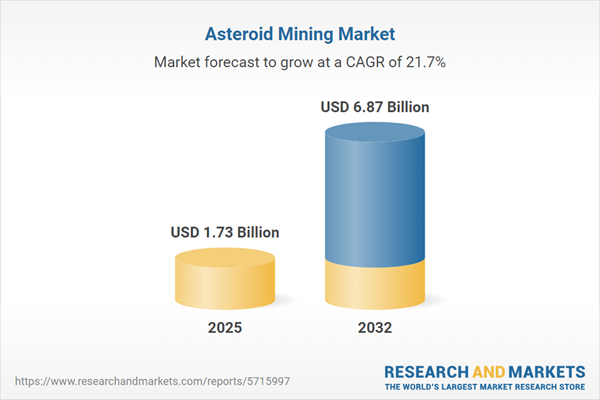Speak directly to the analyst to clarify any post sales queries you may have.
The asteroid mining market is evolving, presenting senior decision-makers with practical opportunities to lead in space resource utilization. As technology advances and regulatory landscapes shift, organizations can leverage these developments to innovate operational models and expand resource access.
Market Snapshot: Asteroid Mining Market Overview
The global asteroid mining market reached USD 1.42 billion in 2024, with a projected CAGR of 21.70%. Forecasts suggest expansion to USD 1.73 billion by 2025 and USD 6.87 billion by 2032. Growth is driven by robust private investment, technological improvements in propulsion, robotics, and extraction, and strategic collaborations within both public and private sectors. Organizations are recalibrating business models in response to shifting resource dynamics, evolving commodities markets, and diverse procurement strategies. Regulatory environments now encourage adaptive operational frameworks, prompting the sector to adopt new partnership approaches and reflect changing requirements in global resource management.
Scope & Segmentation: Strategic Insights for Decision-Makers
This asteroid mining market report is tailored for senior executives seeking reliable benchmarking and growth opportunities in an emerging high-value sector. By dissecting core segments and geographies, the report facilitates alignment with technological transitions, policy shifts, and changing supply chain expectations. Strategic segmentation provides actionable perspectives on where and how leading organizations can enhance competitiveness and unlock value streams.
- Resource Types: Helium-3 is spearheading initiatives in the energy sector; gold and platinum group metals contribute to greater supply chain stability for industrial applications; rare earth elements drive innovation in the electronics industry; and water serves essential functions in both space operations and terrestrial logistics networks.
- Mission Stages: Organizations are prioritizing robust retrieval systems for safe resource extraction; advances in processing and refining technologies are improving operational efficiency; enhanced prospecting capabilities are supporting more effective strategic planning and helping to minimize project risks.
- End Markets: Demand for asteroid-derived materials spans industrial exports, aerospace production, space-based and terrestrial manufacturing, and energy solutions, with each end-user seeking access to diversified resources to strengthen supply reliability.
- Technologies: Autonomous robotics are driving scalability and consistency; AI-driven drones ensure targeted extraction; teleoperated systems deliver safer operations; and human-led missions are strategically deployed where project conditions require advanced adaptability.
- Geographic Regions: The Americas, particularly the US, Canada, and Brazil, exhibit nimble adoption of new business models; EMEA institutions navigate complex legal frameworks and include influential hubs in the UK, Germany, Russia, and South Africa; Asia-Pacific, led by China, India, Japan, and Australia, aligns regulatory approaches and strategy execution with localized imperatives.
- Key Players: Market leadership is held by ispace Inc., AstroForge, OffWorld Inc., Shackleton Energy, TransAstra Corporation, Deep Space Industries, Planetary Resources, Effective Space Solutions, Asteroid Mining Corporation, and Origin Space Technology.
Asteroid Mining Market: Key Takeaways for Senior Decision-Makers
- Investment in advanced propulsion systems and automation technologies is elevating operational flexibility across mission lifecycles, allowing streamlined transitions from exploration to processing stages.
- Collaborative partnerships, including public-private partnerships and cross-organization consortia, enable risk-sharing and rapid infrastructure scaling, enhancing project implementation in new markets.
- Regulatory updates are increasing industry participation, prompting strategic reviews of partner selection and bidding strategies while reinforcing collaborative networks to build operational resilience.
- Integration of automated workflows boosts the reliability of resource supply by equipping companies to anticipate and respond to market fluctuations without compromising service delivery.
- Continuous updates to mining technologies support fast compliance with technical and policy standards, allowing organizations to align swiftly with evolving industry protocols.
Tariff Impact: Navigating U.S. Regulatory Shifts in 2025
New U.S. tariffs affecting orbital and asteroid capture equipment are encouraging procurement leaders to diversify supplier portfolios and engage in international partnerships. These regulatory changes are leading organizations to adjust logistics strategies, ensuring flexible compliance and sustained operation in a dynamic policy environment.
Methodology & Data Sources
This research is built on a triangulated methodology, integrating insights from industry experts, operational and procurement data, and regulatory analysis. Findings have been validated by peer-reviewed industry and academic sources, while scenario modeling bolsters actionable, executive-level recommendations.
Why This Asteroid Mining Market Report Matters
- Empowers targeted capital deployment by spotlighting actionable market trends and segment opportunities within asteroid mining.
- Clarifies risk factors tied to regional regulation and compliance, enabling proactive strategic planning and operational assurance.
- Facilitates the synchronization of technology strategy and operational planning for improved resilience during rapid market changes.
Conclusion
Sustained focus on technological innovation, agile operations, and proactive regulatory engagement positions organizations to capture emerging opportunities in the asteroid mining industry. Leaders who prioritize these will secure a competitive edge in this progressing market.
Additional Product Information:
- Purchase of this report includes 1 year online access with quarterly updates.
- This report can be updated on request. Please contact our Customer Experience team using the Ask a Question widget on our website.
Table of Contents
3. Executive Summary
4. Market Overview
7. Cumulative Impact of Artificial Intelligence 2025
Companies Mentioned
The companies profiled in this Asteroid Mining market report include:- ispace Inc.
- AstroForge, Inc.
- OffWorld, Inc.
- Shackleton Energy Company LLC
- TransAstra Corporation
- Deep Space Industries LLC
- Planetary Resources LLC
- Effective Space Solutions Ltd.
- Asteroid Mining Corporation
- Origin Space Technology Limited
Table Information
| Report Attribute | Details |
|---|---|
| No. of Pages | 198 |
| Published | October 2025 |
| Forecast Period | 2025 - 2032 |
| Estimated Market Value ( USD | $ 1.73 Billion |
| Forecasted Market Value ( USD | $ 6.87 Billion |
| Compound Annual Growth Rate | 21.7% |
| Regions Covered | Global |
| No. of Companies Mentioned | 11 |








